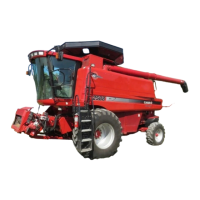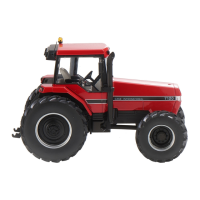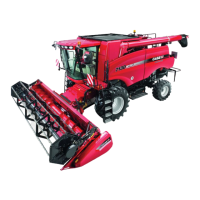STORAGE
33
Combine Storage
When harvest is done, make sure to give your combine some
end-of-season and pre-storage attention before the shed doors
close. Off-season neglect can cost big in terms of corrosive
damage, rust, and deterioration—all avoidable with a little
thought to prevention and maintenance. The combine should
be stored in a dry, protected location. Outside storage, subject
to weather and elements will shorten the life of the machine.
1. The combine should be thoroughly cleaned before storage
to remove chaff and debris that can collect moisture or
attract rodents during storage.
• A high volume and velocity air blower like a leaf blower or
industrial compressor works best when debris is dry
• Washing the unit will provide the most complete cleaning,
removing debris that may be stuck to grease or oily
accumulations that cannot be removed with just compressed
air or mechanical cleaning; as well as removing the grease
and oil as well
• If the unit is washed, care must be exercised to assure
COMPLETE removal of chaff and debris, especially from
inconspicuous areas where it will result in accelerated rust
and corrosion over an extended period of time
• Tightly cover the engine starter and alternator with plastic
before washing the combine
• Avoid directing the blast from a high pressure washer or
steam cleaner against sealed bearings where moisture
that infiltrates the seals will remain and lead to
corrosive damage
• In areas that freeze make sure to remove any water that
maybe trapped in the transition cone, auger bed or grain
tank. All of these areas have removable covers, doors, or
plugs that allow water to drain.
2. After thoroughly cleaning the combine and allowing it to
dry, lubricate the machine as specified in the “Lubrication/
Filters/Fluids section of the Operator’s Manual.
• Remove the coverings from the starter and alternator
3. Clean the inside of the machine including the concave and
separator grate, chaffer and shoe sieves, cleaning fan, clean
grain and tailings auger troughs.
• Open the clean grain and tailings elevator doors
• Open the auger bed front doors and clean the auger bed
4. Clean the inside of the cab and instrument panel. Clean the
cab air and re-circulation filters.
5. Rodents can damage a combine while in storage. Rodents
will eat plastic, insulation, or rubber materials, especially
when coated with grain dust.
• Clean the areas where rodents may nest
• Leave access panels and doors open to remove convenient
nesting pockets. In some conditions, leaving mothballs will
help discourage rats and mice.
6. Run the engine long enough to completely warm the oil in
the crankcase before draining the oil.
• Remove and replace the oil filter as instructed
• Fill the crankcase with fresh oil and run the engine for two
to five minutes
7. Open the drain on the water separator fuel filter and drain
water and sediment.
• Fill the fuel tank with a premium grade diesel fuel
If this fuel grade has not been used regularly, drain the fuel
tank and fill with premium diesel fuel. Do not store the combine
with bio-diesel fuel in the tank or fuel system.
• Run the engine for five minutes to circulate the fuel through
the fuel injection system
• Close the fuel shutoff valve between the water separator
filter and fuel tank to prevent fuel draining from fuel injection
system into the fuel tank
8. Clean the air cleaner filter and body.
9. Check coolant anti-freeze protection. Use only low silicate,
heavy-duty coolant in the cooling system.
• Add cooling system conditioner and change the coolant
filter conditioner
10. Cover the engine breather pipe and exhaust pipe.
11. Batteries can remain in the combine, but must be fully
charged to prevent freezing in cold temperatures.
• Remove the battery ground cables to prevent slow discharge
12. Store the combine out of direct sunlight. Clean tires before
storage and support the combine on blocking if possible to
remove load from the tires.
• If the combine is not blocked, check tires frequently and
maintain inflation during storage
13. Lubricate chains with light oil or chain lubricant.
14. Lower the head to remove load from the hydraulic system.
• Retract all hydraulic cylinders if possible. Coat exposed
cylinder rods with grease to prevent rust and corrosion (clean
grease from rods when removing the combine from storage).
15. Remove tension from belts.
16. On combines equipped with Moisture Sensor, remove the
bypass auger and remove grain from the housing. Make
sure the auger turns freely in the plastic bearing block.
Removing the Combine from Storage
Consult the Operator’s Manual. In addition to confirming fluid
levels and closing cleanout doors, several other inspections are
suggested when preparing the combine for use.

